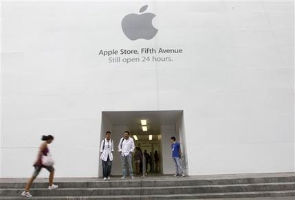- Home
- Mobiles
- Mobiles News
- What iPhone 5 is likely to change
What iPhone 5 is likely to change
By Associated Press | Updated: 6 June 2012 15:28 IST

Click Here to Add Gadgets360 As A Trusted Source

Advertisement
Apple Inc. is unveiling a new, more powerful version of its wildly popular smartphone - more than a year after it launched the iPhone 4.
Last week, Apple Inc. e-mailed invitations to a media event at its headquarters in Cupertino on Tuesday morning. The invite says "let's talk iPhone," implying the secretive company intends to show off the latest version of the device.
The first iPhone came out in 2007, and the phone's signature slick looks, high-resolution screen and intuitive software has gained millions of fans over the years. There were 39 million iPhones sold just between January and the end of June.
Beyond the iPhone itself, the Tuesday event is anticipated as Apple's first major product unveiling in years that won't be led by Steve Jobs, who resigned from the CEO post in August after being out on indefinite medical leave since January. The Apple co-founder is now its executive chairman. And though Jobs did emerge from medical leave twice this year to present Apple's innovations - most recently in June to show off its new mobile software and iCloud content storage service - his successor, Tim Cook, is expected to take the lead this time.
Though not nearly as recognizable as Jobs, Cook, formerly Apple's chief operating officer, has been running Apple since January. For years, he has been in charge of Apple's day-to-day operations, and he has long been seen as the natural successor. He also served as Apple's leader for two months in 2004 while Jobs battled cancer and again for five-and-a-half months in 2009 when Jobs received a liver transplant.
Perhaps more important to Apple fans than who is presenting is what the company will reveal on Tuesday. A new iPhone is expected to have a number of changes, the biggest of which will likely be under the hood: the inclusion of Apple's latest iOS mobile software, iOS 5, which has been slated for release this fall.
IOS 5 will include things such as wireless device setup and content syncing, and beefed-up camera, email and Web-browsing apps. A new service called iMessage will allow iOS 5 users to send text messages to each other over Wi-Fi or wireless carriers' data networks, while a folder called Newsstand will corral newspaper and magazine app subscriptions in one place to make it easier to find them. When it comes out, the software will also be available for Apple's iPad, iPhone 4 and 3GS and the two most recent generations of the iPod Touch.
A new iPhone is also expected to include Apple's forthcoming iCloud service, which will store content such as music, documents, apps and photos on Apple's servers and let you access them wirelessly on numerous devices.
As for hardware, a new iPhone isn't expected to look that much different from the iPhone 4, though it could be thinner and have a bigger screen. The existing iPhone is 0.37 inches thick and has a display measuring 3.5 inches at the diagonal.
An improved rear camera is anticipated, too. The existing iPhone has a 5-megapixel camera on its rear. A number of recently released smartphones have moved to 8-megapixel cameras.
One of the most notable hardware changes many industry watchers are predicting is the inclusion of a more powerful chip: Apple's dual-core A5 processor, which is the same chip it uses in its current iPad. The iPhone 4 runs on Apple's older A4 chip, and the move to a more capable chip should improve things such as multitasking, opening apps and gaming.
Analysts also believe Apple could also use the event to trot out new iPods and updates to its iTunes music software, which it usually does in the fall anyway. Last September, Apple announced updates to iTunes and a line of revamped iPods, which included a version of the iPod Nano with a touch screen.
Last week, Apple Inc. e-mailed invitations to a media event at its headquarters in Cupertino on Tuesday morning. The invite says "let's talk iPhone," implying the secretive company intends to show off the latest version of the device.
The first iPhone came out in 2007, and the phone's signature slick looks, high-resolution screen and intuitive software has gained millions of fans over the years. There were 39 million iPhones sold just between January and the end of June.
Beyond the iPhone itself, the Tuesday event is anticipated as Apple's first major product unveiling in years that won't be led by Steve Jobs, who resigned from the CEO post in August after being out on indefinite medical leave since January. The Apple co-founder is now its executive chairman. And though Jobs did emerge from medical leave twice this year to present Apple's innovations - most recently in June to show off its new mobile software and iCloud content storage service - his successor, Tim Cook, is expected to take the lead this time.
Though not nearly as recognizable as Jobs, Cook, formerly Apple's chief operating officer, has been running Apple since January. For years, he has been in charge of Apple's day-to-day operations, and he has long been seen as the natural successor. He also served as Apple's leader for two months in 2004 while Jobs battled cancer and again for five-and-a-half months in 2009 when Jobs received a liver transplant.
Perhaps more important to Apple fans than who is presenting is what the company will reveal on Tuesday. A new iPhone is expected to have a number of changes, the biggest of which will likely be under the hood: the inclusion of Apple's latest iOS mobile software, iOS 5, which has been slated for release this fall.
IOS 5 will include things such as wireless device setup and content syncing, and beefed-up camera, email and Web-browsing apps. A new service called iMessage will allow iOS 5 users to send text messages to each other over Wi-Fi or wireless carriers' data networks, while a folder called Newsstand will corral newspaper and magazine app subscriptions in one place to make it easier to find them. When it comes out, the software will also be available for Apple's iPad, iPhone 4 and 3GS and the two most recent generations of the iPod Touch.
A new iPhone is also expected to include Apple's forthcoming iCloud service, which will store content such as music, documents, apps and photos on Apple's servers and let you access them wirelessly on numerous devices.
As for hardware, a new iPhone isn't expected to look that much different from the iPhone 4, though it could be thinner and have a bigger screen. The existing iPhone is 0.37 inches thick and has a display measuring 3.5 inches at the diagonal.
An improved rear camera is anticipated, too. The existing iPhone has a 5-megapixel camera on its rear. A number of recently released smartphones have moved to 8-megapixel cameras.
One of the most notable hardware changes many industry watchers are predicting is the inclusion of a more powerful chip: Apple's dual-core A5 processor, which is the same chip it uses in its current iPad. The iPhone 4 runs on Apple's older A4 chip, and the move to a more capable chip should improve things such as multitasking, opening apps and gaming.
Analysts also believe Apple could also use the event to trot out new iPods and updates to its iTunes music software, which it usually does in the fall anyway. Last September, Apple announced updates to iTunes and a line of revamped iPods, which included a version of the iPod Nano with a touch screen.
Comments
Catch the latest from the Consumer Electronics Show on Gadgets 360, at our CES 2026 hub.
Related Stories
Popular on Gadgets
- Samsung Galaxy Unpacked 2025
- ChatGPT
- Redmi Note 14 Pro+
- iPhone 16
- Apple Vision Pro
- Oneplus 12
- OnePlus Nord CE 3 Lite 5G
- iPhone 13
- Xiaomi 14 Pro
- Oppo Find N3
- Tecno Spark Go (2023)
- Realme V30
- Best Phones Under 25000
- Samsung Galaxy S24 Series
- Cryptocurrency
- iQoo 12
- Samsung Galaxy S24 Ultra
- Giottus
- Samsung Galaxy Z Flip 5
- Apple 'Scary Fast'
- Housefull 5
- GoPro Hero 12 Black Review
- Invincible Season 2
- JioGlass
- HD Ready TV
- Laptop Under 50000
- Smartwatch Under 10000
- Latest Mobile Phones
- Compare Phones
Latest Gadgets
- OPPO Reno 15 Pro Max
- Honor Win RT
- Honor Win
- Xiaomi 17 Ultra Leica Edition
- Xiaomi 17 Ultra
- Huawei Nova 15
- Huawei Nova 15 Pro
- Huawei Nova 15 Ultra
- Asus ProArt P16
- MacBook Pro 14-inch (M5, 2025)
- OPPO Pad Air 5
- Huawei MatePad 11.5 (2026)
- Xiaomi Watch 5
- Huawei Watch 10th Anniversary Edition
- Acerpure Nitro Z Series 100-inch QLED TV
- Samsung 43 Inch LED Ultra HD (4K) Smart TV (UA43UE81AFULXL)
- Asus ROG Ally
- Nintendo Switch Lite
- Haier 1.6 Ton 5 Star Inverter Split AC (HSU19G-MZAID5BN-INV)
- Haier 1.6 Ton 5 Star Inverter Split AC (HSU19G-MZAIM5BN-INV)
© Copyright Red Pixels Ventures Limited 2025. All rights reserved.

















